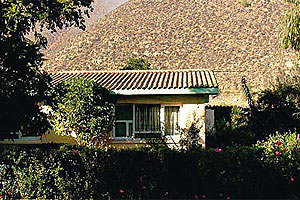The Alicanto
It is a mythological bird that lives in small caves amongst the hills of minerals in the Atacama desert and its appearances are anxiously awaited by fortune hunters.
This creature, which feeds on gold and silver, is enormous; it has large metallic colored wings, a curved beak and feet with powerful talons.
Also, it has the particular trait that its wings glow at night. This way, if it had fed on gold it would give off golden reflections as it flew, and if it had been silver, the shine was silver.
If the Alicanto’s crop was full, it could not fly due to the metals it had eaten. After that, it headed towards its nest where it would lay two eggs, depending on the type of metal it had fed on.
It is said that whoever decided to follow the Alicanto became rich, because the bird was capable of leading them to the exact spot where there were rich deposits or to places where there was buried treasure.
However, if the Alicanto felt chased, it would darken its wings and become lost in the night. In addition, sometimes it used quick movements and sometimes it used slow movements to disorient the miner who was following it. Finally, it cast a blinding light upon its pursuer, leaving them sightless in the middle of an unknown road, and only through a prayer for the virgin of Punta Negra could the miner find the road back home.
Stories also say that if the person chasing the bird had unbridled ambition, it would get angry and take them to the edge of a cliff, where the miner would fall and die.
For this reason, the person trailing the bird had to do so quietly and only spy on the place where it fed from a safe distance. After the bird had eaten and begun its flight, the man could get near to the gold or silver deposit. (Version based on Oreste Plath’s compilation).
The Yastay
Also known as the Yestay, it is a guanaco that protects the herds and stands out from the rest because of its great size and beauty. It is believed that this animal was the head of all the other animals and had the particular trait of appearing at the most unexpected moment. Sometimes, the appearance of this animal was not a pleasant sight to see, for when it unleashes all of its fury against hunters, it reveals itself with a demon head and spitting fire from its mouth. Yet, on other occasions, it would appear with a tender face and can even act as a guide in the middle of the desert when it detects the kindness of those who approach its protégées. Its favorite food is cocho with quintitaco (Chilean sweet mesquite) flour.
If anyone wishes to hunt an animal, they must ask the Yastay for permission and leave an offering between the stones of the hill.
Also, this animal protects poor hunters that only catch animals for food and punishes those that hunt without need. It is said that on certain occasions it takes on human form to make deals with people.
The Lola
This legend was developed in the Antofagasta area during the time when Chile was being discovered. Back then, there was a beautiful woman named Lola who had a father that lived only to take care of her and keep her away from the men who were in love with her. This man was known for his nickname, “vagabundo” (vagrant), because he would go on trips by himself looking for mines and he took several journeys along the coast on his little boat.
On the other hand, Lola would give hope to men and then crush that hope, which caused great jealousy amongst the women.
One day, she met a man she fell hopelessly in love with, but he loved another woman. Lola lived to hate her rival, who a beautiful blond, and spied on the happy couple everyday.
This went on until one night she headed barefoot and quietly to the room where the man that made her suffer was sleeping peacefully and she drove a dagger through his heart, causing his death. At that moment, she fled to the hills voicing screams and shrieks.
The follow day, once the crime was out in the open, Lola’s father went to look for her, but the inclement climate and lack of water ended his life.
Some time later, the young girl returned to town, but she was suffering madness and only wandered about and laughed until she died shortly after. From that moment on, her and her vengeful spirit roam the hills surrounding the area. (Version based on Oreste Plath’s compilation).
The Añañuca
It is a typical flower of the northern zone of our country which grows specifically between Copiapo (region of Atacama) and the Quilimari valley (region of Coquimbo). Few people are aware that it gets its name from a sad love story. The legends goes that during the time before Chile’s Independence, in the town of Monte Patria, there lived Añañuca, a beautiful indigenous young woman that all the men wanted to win over, yet nobody could do it.
One day, a miner arrived to town that was looking for gold. When he met Añañuca, love sparked between them, so they decided to get married.
The couple was happy for awhile, but one night, the young man had a dream in which a goblin revealed to him the spot where the mine he had been looking for for so long could be found. The next morning, without telling anybody, not even his wife, he set off to find it.
Añañuca, devastated, waited and waited, but days, weeks and months went by and the young miner never returned.
It is said that he fell victim to the mirages of the pampas or to a storm, causing him to despair and, presumably to die.
Añañuca died shortly after due to the great sorrow brought on by losing her loved one. She was buried by the townspeople in the heart of the valley on a day in which a light shower was coming down. The follow day, the sun came up and all of the town’s inhabitants got to see a surprising event. The place were the young woman had been buried was covered by a lush layer of red flowers.
From that moment on, people are sure the girl became a flower as an act of love towards her husband, for this way they could always be together.
This is how this flower got the name Añañuca.
The Tale of Juan Soldado
The story goes that several centuries ago, in the city of La Serena, there lived a poor man called Juan Soldado. This man fell in love with the only daughter of a wealthy cacique (chief) who lived in the outskirts of town. After a while the couple decided to get married, but the father, upon hearing such news, was against it. So, the couple decided to run away and get married in secret at the church of La Serena.
Just as the priest was blessing the couple, people from the city entered the church to warn them that the cacique was coming along with his revved up youngsters, saying that he would destroy the city and kill the love birds. No one knows how it happened, but after the mob entered La Serena, the city disappeared.
This way, it is said that on certain nights, especially on Saturday, those that pass near the place where the old city was built hear music and songs, and on Good Friday, the city becomes visible to those looking on from afar, but the image fades little by little.
Another version of the story says that during Colonial times, there was a Spanish soldier in La Serena named Juan. One day, he killed two wealthy countrymen on the street who had mocked him when they saw how poorly he was dressed. From that moment on, the young man disappeared, leaving only his sword on the ground.
Months later, a light shined at the top of a hill every night. However, the light went out. When onlookers arrived to this place, they found Juan the soldier, dead and wrapped in monk’s clothes. At that moment, it was decided to name the hill Juan Soldado (Version based on Oreste Plath’s compilation).
Other northern myths and legends
– The wells of Pica: when the Spanish arrived to Pica, they were not warmly welcomed by the natives, so they moved on to Matilla, where they founded a town.
One of the Spaniards named Damaso Morales well in love with the daughter of the cacique of Pica.
Morales asked her father’s permission to marry the girl, but he refused. However, the Spanish man insisted on his request and the cacique said he’d have no problem giving up his daughter’s hand in marriage as long as he could make the valley between Pica and Matilla bloom.
Although it was a nearly impossible mission for the young man, he started to dig the first well in the place, managing to obtain water. This made the entire valley bloom, so he accomplished what he set out to do in the first place, marry the cacique’s daughter. (Version based on Oreste Plath’s compilation).
– The cave of Salamanca: it is said this is the cave where one learns he art of witchery. The souls of deceased warlocks are within this cave, who gave power to those first entering the trade.
In addition, Satan is worshipped here, black masses are held and warlocks and witches make their confessions as well. A single religious word or the sign of the cross could dissolve an assembly.
Every now and again, parties are held attended by the masters and they use gold and silver cutlery. However, not a piece of silverware can leave this layer, for they become worthless once outside.
One time, a warlock invited a young man to one of these parties and when he was alone he stuck a silver spoon in his pocket. At that moment, he saw a beautiful girl approaching him and shortly after he awoke in the town plaza reminiscing on what had occurred. He put his hands in his pockets to see if he had the spoon, but he only came up with a marble. (Version based on Oreste Plath’s compilation).
– The treasure of the Inca: just when Incan Atahualpa died (1533), a caravan was taking fourteen and a half arrobas of gold to Cuzco (Peru) for him. However, when the committee heard that the indigenous chief had passed away, the indigenous people, not knowing what to do with the treasure, sent it to the bottom of the lagoon on Quimal hill, in the Atacama desert.
It is said that the locals have managed to pull some objects from the lagoon, but afterwards, each of them have had bad luck in their lives. (Version based on Oreste Plath’s compilation).








 Día Mundial del Libro y del Derecho de Autor
Día Mundial del Libro y del Derecho de Autor